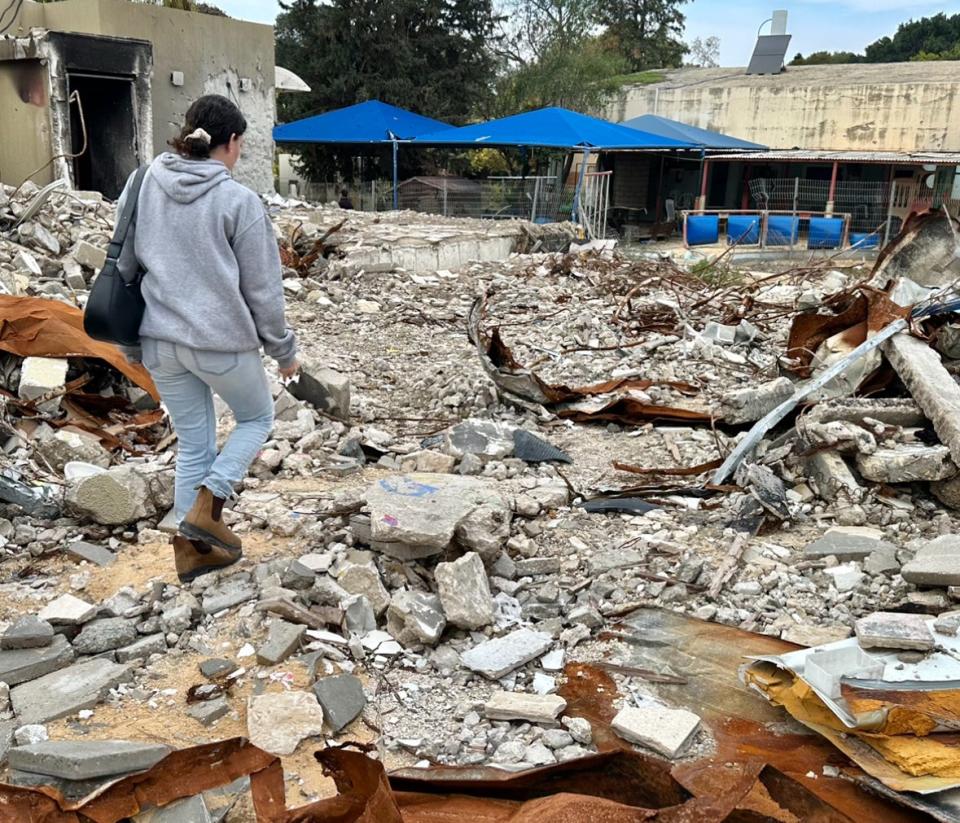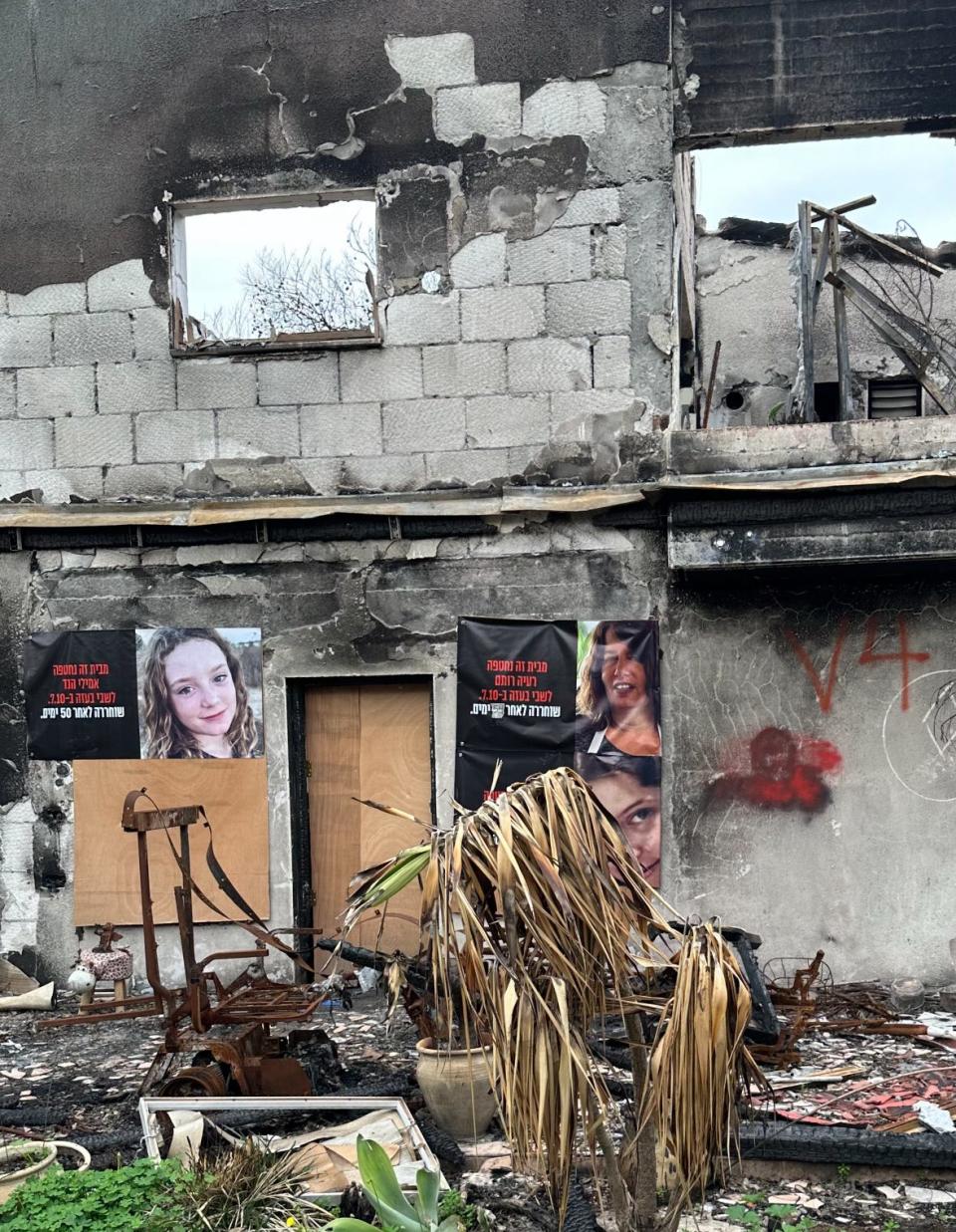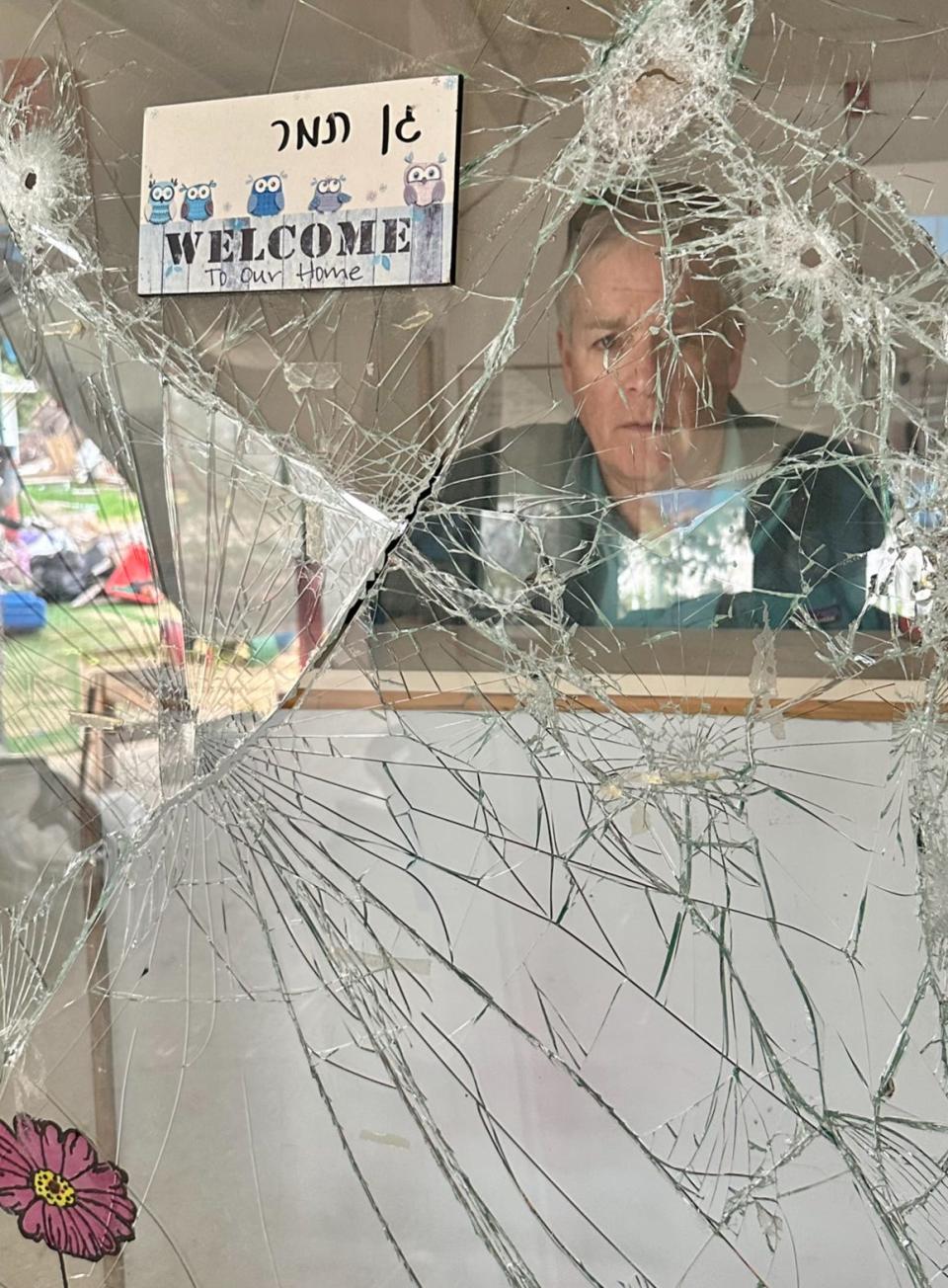Mark Patinkin in Israel: Faces of the dead a haunting presence at Kibbutz Be'eri
The first thing you see as you enter Kibbutz Be’eri are the burned homes, but soon you notice something more unsettling.
Hamas wasn’t satisfied to just set fire. What wasn’t burned was smashed, leaving hardscaped patios in jagged pieces. They did to the houses what they did to the people – first they murdered, then they mutilated.
You can tell it was once a beautiful refuge, Be’eri, the kind of small town that promises you’ll be safe. More than 1,200 lived here; 100 were butchered.
We meet Nectar Shavit, 26, at the entry gate. Be’eri was her home. She has volunteered to show us the little that’s left of it.
The landscaping is impressive, the plantings around each block giving a sense of being part of nature. There’s an emphasis on flowering bushes, and you wonder if you’d be able to smell their fragrance were it not for the aroma of burnt things, even all these months later.

Nectar is quiet, even melancholy, as we walk to a destroyed house at the start of our tour. It’s where her parents had lived.
I would later learn that this was the first time Nectar had shown Be’eri to visitors. When I ask why now, she says it’s because people are denying it happened. This is her way of answering them.
It’s one reason many of us have come. As with all of history’s massacres, there is only one thing you can do for the dead, and that is to bear witness.
The home of Nectar’s parents was a one-story townhouse adjoining another. It’s now burned-out and smashed, half the roof missing. It has been left that way on purpose. Most shrines to massacres have been sanitized, but Be’eri, at least for the moment, is meant to be a testimony rather than a memorial.
Her parents’ house has an open design, the kitchen and living area forming a great room. Outdoor light comes in through the jagged, half-missing roof. The floor is covered with broken masonry and wallboard. The ceiling over the kitchen is intact but blackened, the foil gone from the heating ducts. There are kitchen implements on the ground and canisters on the shelves. I think one has coffee grounds in it, though the soot makes it hard to tell. Somehow, there is an intact box of Hanukkah candles on a table.
When we go back outside, we see the adjoining townhouse was also destroyed. On the front of it, there are big posters of the couple who'd lived there. The father’s name was Ilan Weiss. He was 53. When he went outside to defend his family, they murdered him. Then they kidnapped his body into Gaza. His wife, Shriri, and daughter, Noga, 18, were also taken into Gaza but released 50 days later in the one exchange.

As we move along, I ask Nectar if I can take her picture, but she demurs. If there’s to be a picture, she says, it should include what Hamas did here. Nectar has black, curly hair tied behind with a scrunchie. She wears a gray sweatshirt over faded blue jeans. She has yet to smile.
Her parents survived in a safe room with her 17-year-old brother, Israeli soldiers rescuing them just before they likely would have been killed.
Nectar was in a different house with her husband. At one point, Hamas people knocked. By grace, they moved on. But she heard shooting and constant explosions close enough that she kept thinking she would be next.
The people of Be’eri have a WhatsApp text group. That’s how they communicated during the 12-hour attack. Nectar kept seeing messages with words like, “They’re burning my house; they’re killing my children.”
It began at 6:30 a.m., and the army didn’t arrive until almost 5 p.m. By then it was dark. And there was still an hours-long house-to-house fight. In some buildings, Hamas killers had barricaded themselves with hostages. When Israeli soldiers at last came to Nectar’s home, she pleaded with them to save her parents. They told her they were trying. By then, many Israeli soldiers had been wounded. And Be’eri residents were warned by text that their houses were booby-trapped.
It wasn’t until 10 p.m. that Nectar’s parents were rescued from their safe room. They had been in it since 7 a.m. When it was over, as she walked around, Nectar saw the bodies of neighbors. She saw families, but many were missing members.
We continue down the block. At one point, there’s a loud explosion from Gaza. Then another, and another.
I was using my phone’s voice memo app to record Nectar speaking. When I later transcribed it, I missed some of her words because of the loud crunch of our shoes walking over broken things.
As we move along, Nectar tells us stories from various houses. In this one, an 8-year-old girl hiding under a bed saw her mother kidnapped. Then she heard the Hamas people abuse and kill the family dog. Then they burned the dog. Then they began to burn the house. Somehow, the girl ran out a back entrance and to the home of another family without being seen.
The stories kept coming. This was where girls were raped, that’s where babies were burned. A mother was shot in the head here, the father in the stomach. One neighborhood of Be’eri is called Kerem. Virtually everyone there, says Nectar, was murdered or dragged into Gaza.
Many of the bodies were intentionally burned – not in a house fire, but with kerosene poured on them. Forensics people later determined that some had been burned alive.
After several blocks, we reach the kibbutz recreation area. Nectar points out a swimming pool.
“You have a pool?” I ask.
It gets a smile for the first time. Yes – and more. There is also a full-length basketball court covered from the sun by an awning. They had a petting zoo and a communal dining place.
“You had everything,” I say.
“Yes. Everything.”
The kindergarten area is the hardest to see. A window with fractures and a bullet hole catches my attention. To remember, I ask Robby, my guide and translator, to take a picture of me through it.
I walk into the kindergarten’s wash-up area, a big space. It’s mostly demolished, but the charmingly low sinks for small children are still intact. Among the ruins is a large stuffed dog left on a chair.

In the nearby medical center, I see a poster in a burned-out room of a young woman named Amit Man. “Murdered here,” the poster says in English.
Nectar tells us 14 others were slaughtered in the medical center. One nurse survived by hiding. Many of the dead here and throughout the kibbutz bled out after being shot. That’s how long it took for help to come.
We pass several other tours, some of them Israelis, one a group wearing bulletproof vests from a New York temple. In the hour we are here, Nectar tells us we had seen only part of the community. The attack was too vast to be able to see it all.
Some blocks were missed by Hamas and seem ordinary, reminders of how lovely this community was. But, as in all places where terrible things have happened, whether it be Gettysburg or Normandy or here, your knowledge of events brings you to feel spirits around you.
I ask Nectar where she and her husband are living now.
With a family in Tel Aviv.
Does she have hobbies?
Yes – yoga and jogging. She’s studying computer game design. Her favorite game is Fortnite.
I ask what she loves most about Be’eri.
“Everything,” she says.
Does she plan to come back?
“It’s my hope.”
When does she think that will be?
She pauses.
“One day,” she finally says.
And then she says it again.
Mark Patinkin is traveling to Israel personally and is not sponsored by or affiliated with any organization. He will report firsthand from the region as he has done for the last four decades through his award-winning journalism. He can be reached at mpatinki@providencejournal.com.
This article originally appeared on The Providence Journal: Visit to Kibbutz Be'eri in Israel show Mark Patinkin what's been lost

